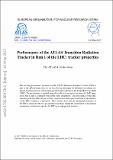Performance of the ATLAS Transition Radiation Tracker in Run 1 of the LHC: tracker properties

View/
Author
Note: Order does not necessarily reflect citation order of authors.Published Version
https://doi.org/10.1088/1748-0221/12/05/P05002Metadata
Show full item recordCitation
ATLAS Collaboration. 2017. “Performance of the ATLAS Transition Radiation Tracker in Run 1 of the LHC: Tracker Properties.” Journal of Instrumentation 12 (05) (May 3): P05002–P05002. doi:10.1088/1748-0221/12/05/p05002.Abstract
The tracking performance parameters of the ATLAS Transition Radiation Tracker (TRT) as part of the ATLAS inner detector are described in this paper for different data-taking conditions in proton-proton, proton-lead and lead-lead collisions at the Large Hadron Collider (LHC). The performance is studied using data collected during the first period of LHC operation (Run 1) and is compared with Monte Carlo simulations. The performance of the TRT, operating with two different gas mixtures (xenon-based and argon-based) and its dependence on the TRT occupancy is presented. These studies show that the tracking performance of the TRT is similar for the two gas mixtures and that a significant contribution to the particle momentum resolution is made by the TRT up to high particle densities.Other Sources
https://arxiv.org/abs/1702.06473Terms of Use
This article is made available under the terms and conditions applicable to Open Access Policy Articles, as set forth at http://nrs.harvard.edu/urn-3:HUL.InstRepos:dash.current.terms-of-use#OAPCitable link to this page
http://nrs.harvard.edu/urn-3:HUL.InstRepos:33058584
Collections
- FAS Scholarly Articles [18292]
Contact administrator regarding this item (to report mistakes or request changes)


